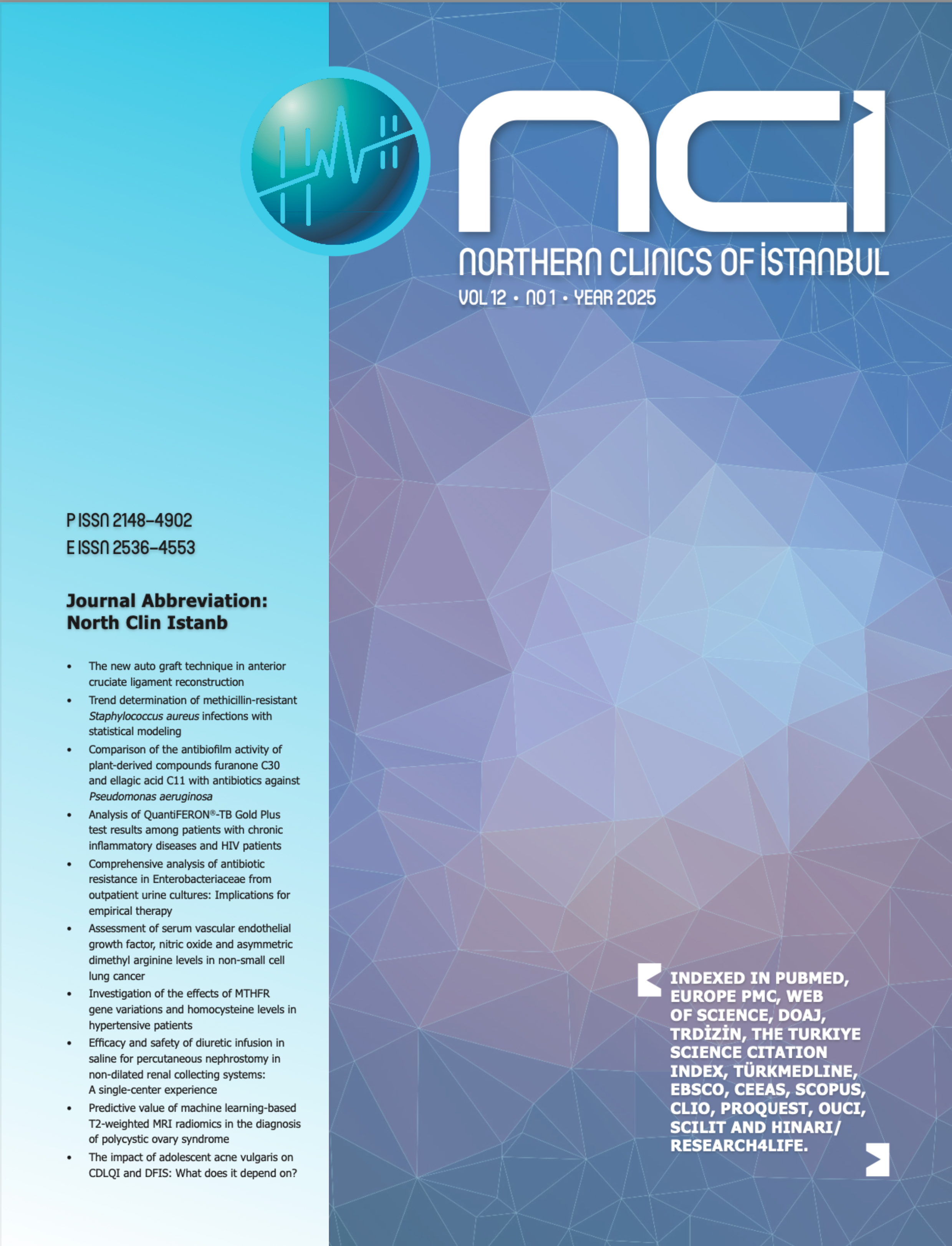Volume: 8 Issue: 2 - 2021
| RESEARCH ARTICLE | |
| 1. | Investigation of double-carbapenem efficiency in experimental sepsis of colistin-resistant Klebsiella pneumoniae Imran Kosar, Gokcen Dinc, Esma Eren, Yusuf Aykemat, Mesut Kilic, Huseyin Kilic, Mehmet Doganay PMID: 33851073 PMCID: PMC8039106 doi: 10.14744/nci.2020.14238 Pages 113 - 118 OBJECTIVE: Klebsiella pneumoniae, a Gram-negative pathogen, especially which produces carbapenemase, is seen as a major threat to public health due to rapid plasmid-mediated spread of resistance and limited therapeutic options available for treatment. Although colistin has been recognized as a last resort antimicrobial for multidrug-resistant K. pneumoniae infections, these isolates have developed resistance to colistin as a result of its intensive use. The aim of this study was to evaluate the efficacy of double-carbapenem treatment of colistin-resistant K. pneumoniae experimental sepsis in mice. METHODS: In the study, 810-week-old Balb-c mice were divided as control groups (positive and negative) and treatment groups (colistin, ertapenem+meropenem, and ertapenem+meropenem+colistin). Sepsis was developed in mice by an intraperitoneal injection of colistin resistant K. pneumoniae. Antibiotics were given intraperitoneally 3 h after bacterial inoculation. Mice in each subgroup were sacrificed with overdose anesthetic at the end of 2448 h and cultures were made from the heart, lung, liver, and spleen. Furthermore, homogenates of lung and liver were used to detect the number of colony-forming units per gram. Bacterial clearance was evaluated in lung and liver at different time points. RESULTS: When the quantitative bacterial loads in the lung and liver tissues are evaluated, no statistically significant difference was observed between different antibiotic treatments (p>0.05). All three treatment options were not effective, especially in 24 h. Only the decrease in bacterial load at the 48th h of the group treated with ertapenem + meropenem + colistin was found significant (p<0.05) compared to the 24 h. CONCLUSION: In the light of these data, it was understood that double-carbapenem application was not sufficient in the treatment of experimental sepsis in mice with colistin-resistant K. pneumoniae. Furthermore, ertapenem + meropenem + colistin combined therapy was not found to be superior to colistin monotherapy or double-carbapenem therapy. |
| 2. | ICU admission rates in Istanbul following the addition of favipiravir to the national COVID-19 treatment protocol Abdullah Emre Guner, Aral Surmeli, Kemal Kural, Habip Yilmaz, Erdogan Kocayigit, Esra Sahin, Perihan Alkan, Cemal Kazezoglu, Serdal Zelyurt, Kemal Memisoglu, Isil Maral PMID: 33851074 PMCID: PMC8039109 doi: 10.14744/nci.2021.60420 Pages 119 - 123 OBJECTIVE: The objective of this study was to understand the observational relationship between adoption of favipiravir into the national COVID-19 treatment protocol and intensive care unit (ICU) admission rates in Istanbul due to COVID-19. METHODS: Data were harvested from the Public Health Management System-HSYS, which collate centrally the records of all known cases of COVID-19. The total number of cases, numbers admitted to ICU, and number undergoing intubation were compared between 2 time periods: 11th of March, the date on which the first case in Turkey was confirmed, to 30th of March; and March 30, to 10th of April, 5 days after Favipiravir was introduced into the treatment algorithm when, the records were examined. RESULTS: The percentage of patients requiring ICU admission diminished from 24% to 12%, whilst the percentage intubated fell from 77% to 66%. These differences were both statistically significant. CONCLUSION: The addition of favipiravir to the national COVID-19 treatment protocol may explain this rapid decrease in the rate of ICU admissions and intubation. |
| 3. | Characteristics and clinical outcome of pT1a-b node-negative breast cancer Abdilkerim Oyman, Mustafa Basak, Hatice Odabas, Melike Ozcelik PMID: 33851075 PMCID: PMC8039097 doi: 10.14744/nci.2020.06332 Pages 124 - 129 OBJECTIVE: Tumor size, along with other clinicopathological characteristics, has a prognostic role in breast cancer. Recurrence risk tends to rise as tumor size increases. Early T-stage portends a good prognosis. We aimed to investigate the recurrence-free interval rates of T1abN0 group of early breast cancer. METHODS: Patients diagnosed with pT1a and T1b, lymph node metastasis-negative breast cancer were included in the study. Clinicopathologic characteristics including recurrence, distant metastasis, and final status of the patients were obtained retrospectively from the patient files. RESULTS: A total of 84 patients included. Twenty-six patients (31%) had T1a and 58 patients (69%) had T1b tumors. The 5-year distant relapse-free survival (DRFS) rate of T1ab tumors was 95.2%. The DRFS rate of T1a tumors was 96.2%, while the rate of T1b tumors was 94.8% (p=0.555). The 5-year RFS rate of T1ab tumors was 90.5%. The RFS rate of T1a tumors was 84.6%, whereas the rate of T1b tumors was 93.1% (p=0.359). The 5-year DRFS rate of hormone receptor positive group was 97%, Her-2 positive group was 81.8%, and triple negative group was 100% (p=0.041). The 5-year RFS rate of the hormone receptor positive group was 97%, Her-2 positive group was 72.7%, and triple negative group was 57.1% (p=0.001). CONCLUSION: The results of the study provided that both T1a and T1b tumors have a good and similar prognosis. |
| 4. | Validity and reliability of the Turkish version of brief diabetic foot ulceration risk checklist Berna Dincer, Emel Mete, Mustafa Kanat, Hasan Aksoy, Necmettin Akdeniz, Demet Inangil, Gökhan Inangil PMID: 33851076 PMCID: PMC8039111 doi: 10.14744/nci.2021.72558 Pages 130 - 138 OBJECTIVE: This study aims to determine the validity and reliability of the Turkish translation of brief diabetic foot ulceration risk checklist (BDURC). METHODS: This methodological study was conducted at the diabetes clinic of a state hospital in Istanbul, Turkey. The data were collected with the BDURC developed by Zhou et al. in 2018. A study was conducted with 430 patients with Type 2 diabetes. The scale was retested after 4 weeks by 60 participants. Language equivalence of the scale was provided. Experts opinions were taken about the content validity of the scale. Reliability of the scale was determined with the test-retest reliability, item-total correlation, and internal consistency analysis. RESULTS: Confirmatory factor analysis revealed a two-factor structure with good model suitability. Cronbachs alpha coefficient for the scale and its subscales was 0.79. Test-retest scores showed no statistically significant difference between the items (p>0.05). The reliability index was higher than 0.80. CONCLUSION: The BDURC-TR is a valid and reliable tool that can be used in clinics to identify the risk factors for diabetic foot ulcers in patients with Type 2 diabetes in Turkey. |
| 5. | The evaluation of relationship between polypharmacy and anticholinergic burden scales Saadet Koc Okudur, Özge Dokuzlar, Ali Ekrem Aydin, Suleyman Emre Kocyigit, Pinar Soysal, Ahmet Turan Isik PMID: 33851077 PMCID: PMC8039107 doi: 10.14744/nci.2020.17136 Pages 139 - 144 OBJECTIVE: Polypharmacy and anticholinergic burden are the indicators for the evaluation of the quality of pharmacotherapy in older adults. The aim of this study was to consider which anticholinergic burden scales are more related with polypharmacy among older patients. METHODS: Four hundred and twenty older adults were evaluated retrospectively in this cross-sectional study. The patients demographic data, comorbidities, the drugs, and number of drugs were recorded. Anticholinergic burden scales were calculated by a tool named anticholinergic burden calculator. RESULTS: The participants mean age was 73.08±8.71. The prevalence of polypharmacy was 32.14%. The highest relationship with polypharmacy was observed for drug burden index (DBI) (odds ratio 10.87, p<0.001). CONCLUSION: Our study demonstrated that polypharmacy and DBI scores were more related than other anticholinergic burden scales in older adults. |
| 6. | The evaluation of dupilumab treatment response in atopic dermatitis patients Ozge Askin, Sera Nur Yucesoy, Server Serdaroglu PMID: 33851078 PMCID: PMC8039099 doi: 10.14744/nci.2020.42375 Pages 145 - 149 OBJECTIVE: This study aims to demonstrate real-life effectiveness of dupilumab treatment in moderate-to-severe atopic dermatitis patients. METHODS: The 14 patients diagnosed with moderate-to-severe atopic dermatitis were included in this study. All of the patients started dupilumab treatment in our faculty between October 2019 and October 2020. The patients were evaluated at the beginning of the treatment and after 12 weeks of treatments. The baseline scoring atopic dermatitis (SCORAD) scores, the total immunoglobulin E (IgE) levels, and the visual analog scale (VAS) of 010 points for itch intensity compared with the post-treatment scores. RESULTS: The SCORAD scores, the serum total IgE levels, and the VAS itch scores of the patients receiving dupilumab treatment dropped significantly following 12 weeks of dupilumab treatment. No significant correlation was demonstrated between the initial SCORAD scores and the serum total IgE values. Besides, no correlation was shown to exist in the reduction of the SCORAD and the serum total IgE values after dupilumab treatment. CONCLUSION: Dupilumab treatment showed significant improvement in disease severity with remarkable reduction in serum total IgE levels. |
| 7. | Is mediolateral episiotomy angle associated with postpartum perineal pain in primiparous women? Halenur Bozdag, Esra Akdeniz, Dondu Demirel Durukan, Erol Arslan, Meryem Hocaoglu PMID: 33851079 PMCID: PMC8039104 doi: 10.14744/nci.2020.23911 Pages 150 - 159 OBJECTIVE: Our aim is to elucidate the relationship between mediolateral episiotomy (MLE) angle and postpartum perineal pain. METHODS: This study was designed prospectively. Primiparous women with MLE in the postpartum period were included in the study and divided into three groups according to episiotomy angle ranges (Group 1: <40°, Group 2: 40°60°, and Group 3: >60°). Postpartum perineal pain was quantified with the short-form McGill Pain questionnaire (SF-MPQ) consisting of the following three parts: Sensory-affective-verbal descriptions, visual pain scale (VPS), and present pain intensity scale (PPI). Postpartum perineal pain scores on days 1 and 7 were compared among the angle group. RESULTS: Overall, 86 eligible women were enrolled in this study. Seventy-three women (85%) scored the perineal pain between 0 and 3 on the VPS and 13 women (15%) rated the pain from 4 to 6 on the 1st postpartum day. No significant differences were noted among the three groups regarding the total pain scores on SF-MPQ and on the each part of form at the 1st postpartum day. At 7 days postpartum, total pain score was found significantly high in Group 1 [Med; IQR (min-max)=0; 4 (05)] compared with Group 2 [Med; IQR (min-max)=0; 0(05)]. The pain scores obtained from the sensory, affective, VPS, and PPI parts of the questionnaire were [Med; IQR (min-max)=0; 1 (02)], [Med; IQR (min-max)=0; 1 (01)], [Med; IQR (min-max)=0; 2 (02)], and [Med; IQR (min-max)=0; 0.25 (01)], respectively, in Group 1. For Group 2, pain scores obtained from the sensory, affective, and PPI were [Med; IQR (min-max)=0; 0(0-1)]; and VPS was [Med; IQR (min-max)=0; 0(0-2)]. No significant differences were observed between Groups 1 and 2 for each part of the questionnaire on day 7. Percentage of need for analgesics on day 7 was found significantly higher in Group 1 (42.9%) than Group 2 (31.2%) CONCLUSION: MLE at an angle <40° to the midline is associated with a higher score of perineal pain and an increase need for analgesics during the early postpartum days. |
| 8. | Comparison of burden of disease in elderly and non-elderly patients with pre-diabetes: A cross-sectional study Ulas Serkan Topaloglu, Kemal Erol PMID: 33851080 PMCID: PMC8039114 doi: 10.14744/nci.2020.89725 Pages 160 - 166 OBJECTIVE: There are a lot of studies comparing elderly and adult patients with diabetes but not pre-diabetes systematically. We aimed to compare the discrepancies of clinical status and burden of disease in elderly (≥60 years old) versus non-elderly (1859 years old) adult pre-diabetics. METHODS: A total of 126 pre-diabetic patients were included in the study and were compared as two groups; the elderly (n=32) and non-elderly (n=94). Fasting plasma glucose (FPG) and glycated hemoglobin (HbA1c) levels, body mass index (BMI), the homeostasis model assessment of insulin resistance (HOMA-IR), health-related quality of life using the short form-36 (SF-36) questionnaire, and disability using the health assessment questionnaire (HAQ) were evaluated. RESULTS: Gender, BMI, the presence of obesity, the ratio of HOMA-IR, FPG, and plasma glucose in the 2nd h oral glucose tolerance test were similar in non-elderly patients with pre-diabetes compared to the elderly ones. However, HbA1c levels were higher in elderly subjects in our study. According to the SF-36 questionnaire and HAQ score, there were no significant differences between groups. The median total HAQ scores were 0.125 (non-elderly) and 0.250 (elderly) for groups and there was no significant difference (p=0.099). CONCLUSION: In the similar gender and BMI groups, pre-diabetes in the elderly gives different outcomes according to HbA1c. Since SF-36 questionnaire and HAQ scores were not statistically different in both pre-diabetic groups, the burden of disease is thought to be basically due to the presence of the disease rather than aging. |
| 9. | Our newborn hearing screening results Suleyman Erdogdu PMID: 33851081 PMCID: PMC8039115 doi: 10.14744/nci.2021.30806 Pages 167 - 171 OBJECTIVE: The aim of the study was to evaluate the results of neonatal hearing screening in our hospital with the help of literature and to question and reveal the risk factors to gain healthy individuals and to raise awareness for all health workers and the public who are interested in this subject. METHODS: A total of 16,388 newborn infants were evaluated between October 2009 and January 2018. All newborns were screened with transient evoked otoacoustic emissions (TEOAEs) test. Risk factors were investigated. The test repetition and auditory brainstem response (ABR) measurements were performed on newborns who could not pass the TEOAE test and the newborns in the risky group after 15 days. RESULTS: A total of 116 newborns (0.7%) were suspected to have hearing loss. Twenty-seven newborns (0.16%) were found to be in intensive care unit. Twelve newborns (0.07%) had permanent hearing loss. Then, in order: 9 newborns (0.05%) had received phototherapy and 7 newborns (0.04%) were born to consanguineous marriages. In addition, 3 newborns (0.02%) had a low birth weight and 1 newborn (0.006%) had a history of fever. CONCLUSION: Screening tests should be performed in all newborns for early detection of hearing loss. Even though frequency of hearing loss is higher in newborns with risk factors, the treatment should be started within 6 months, the latest, and newborns should be referred for rehabilitation and training. |
| 10. | Rhinolithiasis, a rare entity: Analysis of 31 cases and literature review Nurullah Seyhun, Ebubekir Toprak, Kerem Sami Kaya, Senem Kurt Dizdar, Suat Turgut PMID: 33851082 PMCID: PMC8039103 doi: 10.14744/nci.2020.32391 Pages 172 - 177 OBJECTIVE: Rhinolithiasis is a rare condition which results from deposition of salt around a endogenous or exogenous nidus. In the literature, most of the reports are single case studies. In this study, we aimed to present the characteristics, symptoms, diagnosis, and treatment methods of 31 rhinolithiasis cases and to focus on the current literature. METHODS: We retrospectively reviewed 31 rhinolithiasis cases which have been diagnosed and treated in a tertiary care center between January 2014 and December 2018. Patient characteristics, presenting symptoms, concomitant sinonasal disorders, and type of surgery were noted. Descriptive statistics were carried out. RESULTS: Mean age was 25.4±15.7. The cases were comprised 14 female patients (45.2%) and 17 male patients (54.8%). The most common presenting symptom was nasal obstruction (71%). Malodorous unilateral rhinorrhea was present in 17 patients (54.8%). Epistaxis snoring and sleep apnea were other rare symptoms. In 21 of the cases (67.7%), rhinolith was located between inferior turbinate and septum which was the most common location seen in our series. The number of patients who were under the age of 18 was 13, in 2 of them, rhinolith was found to be formed around a plastic bead, and in 2 of them, fruit seeds were the nidus. The most common concomitant sinonasal pathology was septal deviation which was detected in 20 of the patients (64.5%), adenoid vegetation and nasal polyposis were other disorders. In 20 of the patients (64.5%), simple removal of the rhinolith using a forceps with the help of a rigid nasal endoscope was performed. Eight of the 17 patients had severe deviation and septoplasty was performed at the same time, which was the most common concomitant surgical intervention (25.8%). In 3 patients (9.6%), functional endoscopic sinus surgery was performed at the same time. CONCLUSION: Our series is one of the largest series in the literature. The most common presenting symptom was nasal obstruction followed by malodorous rhinorrhea. Accompanying sinonasal disorders should be addressed to improve the outcome. Rigid or flexible endoscopic examination should be used to detect a rhinolith. Computed tomography scan can diagnose a hidden rhinolith in a patient with nasal obstruction. |
| 11. | Polypoid lesions detected in the upper gastrointestinal endoscopy: A retrospective analysis in 19560 patients, a single-center study of a 5-year experience in Turkey Atilla Bulur, Kamil Ozdil, Hamdi Levent Doganay, Oguzhan Ozturk, Resul Kahraman, Hakan Demirdag, Zuhal Caliskan, Nermin Mutlu Bilgic, Evren Kanat, Ayca Serap Erden, Haci Mehmet Sokmen PMID: 33851083 PMCID: PMC8039112 doi: 10.14744/nci.2020.16779 Pages 178 - 185 OBJECTIVE: In our study, we aimed to evaluate the endoscopic features such as prevalence and localization of polypoid lesions determined by us using esophagogastroduodenoscopy and histopathological characteristics of biopsy specimens taken in detail. METHODS: The data of 19,560 patients undergoing upper gastrointestinal endoscopy for any reason between 2009 and 2015 in our endoscopy unit were screened retrospectively and endoscopic and histopathological findings were analyzed in detail. RESULTS: In our study, the polypoid lesion was detected in 1.60% (n=313) of 19,560 patients. The most common localization of the polypoid lesions was determined to be gastric localization (n=301, 96.2%) and antrum with a rate of 33.5% (n=105). When 272 patients in whom biopsy specimen could be taken was investigated, the most frequently seen lesion was polyp (n=115, 43.4%). Hyperplastic polyps (n=81, 29.8%) were the most frequently seen type among all polyps. In histopathological evaluation of the lesions, the prevalence rates of intestinal metaplasia (IM), surrounding tissue IM, atrophy, dysplasia, and neoplasia (adenocarcinoma, squamous cell carcinoma, gastrointestinal stromal tumor, neuroendocrine tumor, and metastatic tumor) among premalignant lesions were determined to be 16.9%, 11.2%, 4.1%, 1.1%, and 3.7%, respectively. CONCLUSION: Polypoid lesions can be seen in endoscopic investigations. In histopathological investigations, while the vast majority of these lesions are benign polyps, some of them are diagnosed as premalignant or malignant lesions. In our study, we determined malignant lesions higher than the similar studies in the literature. This condition shows how effective endoscopic procedure and histopathological evaluation are of vital importance. |
| ORIGINAL IMAGES | |
| 12. | A rare cause of abdominal pain: Mesenteric panniculitis Tolga Duzenli, Huseyin Koseoglu PMID: 33851084 PMCID: PMC8039101 doi: 10.14744/nci.2020.84704 Page 186 NCI-2020-0206.R1 |
| CASE REPORT | |
| 13. | The first kidney transplantation after recipient and living donor recovered from COVID-19 Eyup Veli Kucuk, Dede Sit, Hasan Kayabasi, Ahmet Tahra, Resul Sobay, Seyma Nur Gunes Yilmaz, Cagla Karaoglu, Ezgi Ersoy Yesil PMID: 33851085 PMCID: PMC8039110 doi: 10.14744/nci.2021.70457 Pages 187 - 189 SARS-CoV-2 is still a major threat to the world. In this pandemic, transplantation activities have largely been affected worldwide. We are still facing with this pandemic; however, after regulations, we have started our transplantation activities. We report the first kidney transplantation whose recipient and living donor recovered from COVID-19. A 31-year-old male with renal failure was admitted for transplantation with an ABO-compatible relative. The recipient and the donor were tested for COVID-19 before transplantation, and they were both positive with a polymerase chain reaction. The recipient had minor symptoms and received therapy; the living donor also received therapy. Thirty days after recovery, surgery was performed successfully. The recipient was discharged with mycophenolate mofetil (MMF), tacrolimus, and steroid 15 days after surgery. In the follow-up, they were both negative for COVID-19 45 days after surgery. Although there is missing literature regarding safety concerns and short-term follow-up, living-donor transplantation may be considered for patients, who recovered from COVID-19, after careful selection with paying attention to precautions. |
| 14. | Gemella morbillorum endocarditis in a patient with a bicuspid aortic valve Mustafa Dogan, Aynur Eren Topkaya, Seref Alpsoy, Ozcan Gur, Ilknur Erdem PMID: 33851086 PMCID: PMC8039096 doi: 10.14744/nci.2020.39206 Pages 190 - 192 Gemella morbillorum is one of the rare causative microorganisms of endocarditis. We herein report a case of infective endocarditis in a patient with bicuspid aortic valve caused by G. morbillorum. Infective endocarditis diagnosis was established based on the Modified Dukes criteria. The patient was successfully treated with medical-surgical management. |
| 15. | A rare case about pericardium: Left deviated heart and pericardial agenesis Caglar Kaya, Utku Zeybey, Servet Altay, Fethi Emre Ustabasioglu PMID: 33851087 PMCID: PMC8039098 doi: 10.14744/nci.2019.05935 Pages 193 - 195 Congenital absence of the pericardium is not a common condition in daily practice. There are no obvious and clear symptoms. This condition, which is diagnosed incidentally, may cause some complications when not diagnosed. Therefore, imaging techniques, such as echocardiography, are essential. In this article, we present a rare case of pericardial agenesis. (NCI-2019-0285.R2) |
| 16. | Nephrotic syndrome following hepatitis B vaccination: A 17-year follow-up Bugra Yilmaz, Ozan Ozkaya, Ismail Islek PMID: 33851088 PMCID: PMC8039100 doi: 10.14744/nci.2019.13281 Pages 196 - 198 Some case reports described nephrotic syndrome (NS) associated with administering various vaccines in two last decades. They report only 1 year follow-up. We want to summarize the 17-year clinical follow-up of the patient who had been reported in 2000 because of developing NS after hepatitis B vaccination. Our patient first suffered from NS following hepatitis B vaccination in 4 years old. He had been treated with standard prednisolone regimen resulting in complete remission. After the first diagnosis, he had three relapses in following years. Each relapse developed after Salk, pneumococcal, and flu vaccines, respectively. Relapses had been easily controlled by prednisolone. He had seven relapses until 14 years of age. Fortunately, no relapse has been observed between 2009 and 2016. Although he has been taking alendronate and Vitamin-D for osteoporosis, he is a healthy young adult now. We think that some vaccines may induce relapses in NS, as a triggering factor without being the primarily responsible factors. |
| LETTER TO THE EDITOR | |
| 17. | Urine foaming test, a promising diagnostic test for COVID-19 infection Zeid Khitan, Murad Kheetan PMID: 33851090 PMCID: PMC8039105 doi: 10.14744/nci.2021.13845 Page 199 NCI-2020-0431 |
| 18. | Adaptation of the knowledge about childhood autism among health workers questionnaire aimed for usage in Turkey Borte Gurbuz Ozgur, Erhan Eser PMID: 33851089 PMCID: PMC8039102 doi: 10.14744/nci.2020.65632 Pages 199 - 200 NCI-2020-0028.R1 |
| 19. | Time to collaborate: Objectives, design, and methodology of PeRA-Research Group Betul Sozeri, Hafize Emine Sonmez, Ferhat Demir, Mustafa Cakan, Kubra Ozturk, Semanur Ozdel, Gulcin Otar Yener, Serife Gul Karadag, Nuray Aktay Ayaz PMID: 33851091 PMCID: PMC8039108 doi: 10.14744/nci.2020.25826 Pages 200 - 202 NCI-2020-0238 |
| 20. | The effects of pre-obesity on quality of life, disease activity, and functional status in patients with ankylosing spondylitis Seyma Toy, Davut Ozbag, Zuhal Altay, Ahmet Kavakli PMID: 33851092 PMCID: PMC8039113 doi: 10.14744/nci.2021.15428 Page 202 Abstract | |





















